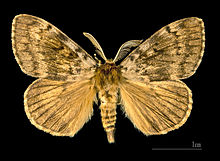Lymantria dispar
| Gypsy moth | |
|---|---|
 |
|
| Mounted Lymantria dispar dispar male | |
 |
|
| Mounted Lymantria dispar dispar female | |
| Scientific classification | |
| Kingdom: | Animalia |
| Phylum: | Arthropoda |
| Class: | Insecta |
| Order: | Lepidoptera |
| Family: | Erebidae |
| Genus: | Lymantria |
| Species: | L. dispar |
| Binomial name | |
|
Lymantria dispar (Linnaeus, 1758) |
|
| Synonyms | |
|
|
Lymantria dispar, the gypsy moth, are moths in the family Erebidae. Lymantria dispar covers many subspecies, subspecies identification such as L. d. dispar or L. d. japonica leaves no ambiguity in identification. Lymantria dispar subspecies have a range which covers in Europe, Africa, Asia, North America and South America.
The European gypsy moth (Lymantria dispar dispar) is native to temperate forests in western Europe. It had been introduced to Canada in 1912 and in the United States in 1869.
The Asian gypsy moth (Lymantria dispar asiatica) is native to southern Europe, northern Africa, Asia and Pacific. It is spreading to northern Europe (Germany, and other countries), where it hybridized with the European gypsy moth. A colony had been reported from Great Britain in 1995.
This moth is an important defoliator on broad-leaf and conifer trees.
The order Lepidoptera contains moths and butterflies characterized by having a complete metamorphosis; larvae transform to pupae and then metamorphosing into adult moths or butterflies. The family is Lymantriidae. Lymantriid larvae are commonly called tussock moths because of the tufts of hair on larvae.
The meaning of the name Lymantria dispar is composed of two Latin-derived words. Lymantria means 'destroyer'. The word dispar is derived from the Latin word that means 'to separate' and it depicts the differing characteristics between the sexes.
The North American gypsy moth and the European gypsy moth are of the same species, often listed as Lymantria dispar dispar. Confusion over the species and subspecies, for classification still exists. The U. S. Department of Agriculture defines the Asian gypsy moth as "any biotype of Lymantria dispar possessing female flight capability", despite Lymantria dispar asiatica not being the only classified subspecies that is capable of flight. Traditionally, Lymantria dispar has been referred to as "gypsy moths" even when referring to Japanese, Indian and Asiatic gypsy moths.
...
Wikipedia
